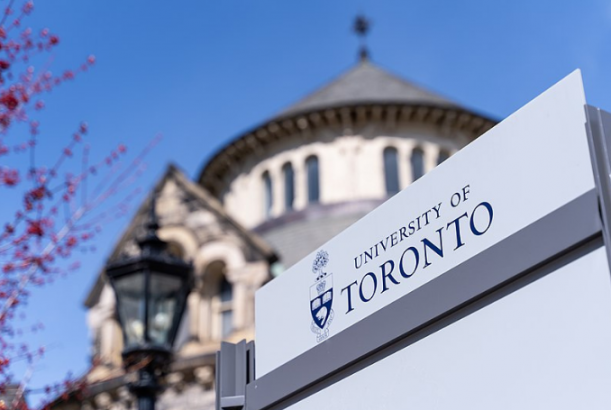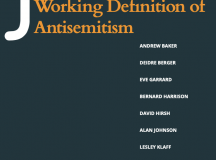David Matas is an international human rights lawyer based in Winnipeg. The author of several books, he is also co-author of the book Bloody Harvest: The Killing of Falun Gong for their Organs. Aurel Braun is a professor of political science and international relations at the University of Toronto. Among his several books is The Extreme Right: Freedom and Security at Risk. In this essay they argue that the recent decision of the University of Toronto to reject the IHRA definition of antisemitism means it now has a policy for Jews and a policy for everyone else, standing against silencing or demeaning speech against all target groups except the Jews. ‘To put it plainly,’ they write, ‘whatever the good intentions of the University of Toronto administration may be, it has effectively created a Jewish/Zionist exception’.
Purportedly recognising the dangers of antisemitism on campus, the University of Toronto administration commissioned an antisemitism Working Group in 2020.[1] A year later, in December 2021, the Working Group released its report. It prominently rejected the adoption of the International Holocaust Remembrance Alliance (IHRA) working definition of antisemitism. The University of Toronto administration responded to the report with remarkable enthusiasm and lightning speed, to accept this rejection. There had been high hopes among many that, by establishing the Working Group, the University of Toronto administration was acknowledging the magnitude of the problem of antisemitism on campus (and worldwide) and the need to address it urgently and effectively. Those hopes have now been dashed.
Rising antisemitism and the worldwide adoption of IHRA
To say that antisemitism is growing worldwide is, if anything, an understatement. In the US, even though Jews constitute only about 2 per cent of the population they were, according to FBI statistics, the target of 58 per cent of all religiously motivated crimes in 2020. In New York City, the Police Department reported that antisemitic hate crimes increased by almost 50 per cent since 2020. According to the Community Security Trust of Britain, antisemitic incidents in the UK hit a record high in the first half of 2021. In Canada, antisemitism increased by over 18 per cent from 2020 alone; according to Michael Mostyn, the CEO of B’nai Brith Canada, anti‑Israel extremism has emerged as the main source of antisemitism in the country in 2021. The University of Toronto itself has had to face serious issues relating to antisemitism at multiple levels.
In the third decade of the third millennium the ancient but ever‑present virus of antisemitism thus, is becoming increasingly more virulent; if it is to be countered effectively it needs to be identified and labelled properly. The definition formulated by the International Holocaust Remembrance Alliance consequently has become an absolutely vital tool.
Though not meant to be legally binding and only a working definition with examples as guides, it is deemed so essential that more than thirty democratic countries have adopted the definition, including virtually all of the major democracies, from the US, UK, France, Germany, Canada, Italy and Spain to South Korea, Australia, Sweden and Switzerland. As well, several observer organisations have committed to the definition, including UNESCO, the Organization for Security and Cooperation in Europe, the European Agency for Fundamental Rights, the European Union and the Council of Europe.
With rapidly burgeoning support for the definition, all the Rectors (Presidents) of Germany’s universities at the Rectors’ Conference, (Hochschulrektorenkonferenz), which represents 268 institutions of higher learning, including all 84 universities and 118 universities of applied sciences, in 2019, at the 27th General Meeting, signed on enthusiastically. Crucially, in their joint resolution they declared that, ‘The definition of antisemitism provided by the International Holocaust Remembrance Alliance (IHRA), which is also recognised by the Federal Government, provides a clear foundation for recognizing hatred towards Jews’. They added that, ‘The member universities of the German Rectors’ Conference emphatically welcome this definition of antisemitism’ and that, ‘It is used in their institutions and is communicated to members’.
In the United Kingdom, the Office for Students reported in November 2021 that over 200 universities, colleges and higher education providers had adopted the IHRA definition of antisemitism, including 95 universities, representing the vast majority of the institutions of higher learning. The universities include Oxford, Cambridge, the London School of Economics and Imperial College. On its website, Oxford states resolutely that, ‘The IHRA definition does not affect the legal definition of racial discrimination, so does not change our approach to meeting our legal duties and responsibilities, including the University’s commitment to uphold freedom of speech’.
In the US, the student governments of at least 30 colleges and universities have taken the lead in adopting the IHRA definition. These include, Penn State, Stanford, Notre Dame, Indiana University and UCLA. Further, as Kenneth Marcus, chair of the Louis D. Brandeis Center for Human Rights Under Law and former assistant U.S. Secretary of Education for Civil Rights, perceptively observed:
The Biden administration has full‑throatedly endorsed the IHRA definition, which is embedded in the Code of Federal Regulations posted on the active policy portal of the U.S. Education Department’s Office for Civil Rights and included in a federal executive order. This means that universities will be held accountable under its terms, whether they adopt it or not. Administrators can ignore the definition, in the same sense that they can ignore federal antitrust law, but they will be held accountable for violations nonetheless.
This growing worldwide momentum to adopt the IHRA definition clearly underlines the recognition among democratic governments, international institutions and leading universities of the alarming growth of antisemitism and the need to address it by starting with the vital identification and the definition that IHRA provides. Adopting the IHRA definition thus has become a litmus test for judging whether a government or institution is serious about effectively fighting antisemitism.
The University of Toronto vs Federal and Ontario governments
The controversy here is not a debate over the wording of the definition of antisemitism. There is a general global consensus on the value of the IHRA definition of antisemitism, including in an ever-growing number of universities. Moreover, the IHRA definition is, outside of Canadian universities, accepted generally across Canada. There is now an unusual situation in which the University of Toronto, by its rejection of IHRA definition by its ‘Jewish exception’, finds itself in opposition to federal and Ontario governments’ interpretation and application of the law. University of Toronto President Meric Gertler, in a Statement on Free Expression, has stated that the University of Toronto ‘must comply with applicable laws’. Yet there is a federal law against hate speech[2] and the Government of Canada has endorsed the IHRA definition of antisemitism. As well, there is an Ontario law against incitement to discrimination[3] and the Ontario Government has also endorsed the IHRA definition of antisemitism. Through endorsement of the Working Group Report, the University of Toronto has in effect said that though the University must comply with applicable laws, the University interprets the hate speech law differently from the Government of Canada and the intent to discriminate law differently from the Government of Ontario.
University of Toronto and Canadian Association of University Teachers
Since the vast and continually increasing support for the IHRA working definition of antisemitism powerfully refutes the naïve, misguided or disingenuous opposition to the adoption of that definition, it is then especially incomprehensible and profoundly disturbing that at Canada’s leading university the administration has chosen to stand against the seminal historical trend supporting the IHRA definition. Sadly though, this is not the first disappointing development at the University of Toronto. The notorious anti‑Israel hatefest ‘Israeli Apartheid Week’ started at the University of Toronto in 2005 and then that anti-Israel hatefest spread around the world.
It should also not be surprising that the Canadian Association of University teachers, (CAUT) promptly jumped on the University of Toronto-led rejectionist bandwagon and opposed the adoption of the IHRA definition of antisemitism at all universities across Canada. This is the same CAUT that in a very rare move in Canada decided to censure the University of Toronto after its Faculty of Law in September 2020 declined to hire an extreme anti-Zionist activist as the Director of the Faculty of Law International Human Rights Program who met neither the advertised nor immigration requirements for the position, basing its censure, despite a mass of evidence to the contrary, on a fantasy claim that the failure to hire the person was politically motivated. CAUT lifted the censure in November 2021 only after the University of Toronto’s Faculty of Law reversed course and offered the activist the position, an offer she declined.
Misstating the Contribution of Kenneth Stern to the IHRA
The University’s Working Group on Antisemitism’s rejection of the IHRA definition and its examples rests heavily on misinterpretations and misunderstandings of the views of one individual – Kenneth Stern. This is highly problematic for three reasons.
- Kenneth Stern is an academic free‑speech absolutist. His absolutism defines his overall approach to academic freedom.
- Kenneth Stern is not the principal drafter of the IHRA definition he claims to be.
- Kenneth Stern is not opposed to the use of the IHRA definition on campuses.
The elaborate attention to the views of Kenneth Stern in this text may seem inordinate. It is necessary, however, in view of the inordinate weight given to his views by those rejecting the IHRA definition of antisemitism.
Stern on academic freedom and freedom of speech
Generally, it is inappropriate to cherry‑pick the views of one individual and then to rely on select interpretations of those alleged views to make decisions. Here specifically, with the Working Group relying significantly on the views of Kenneth Stern in assessing the IHRA definition of antisemitism, the University of Toronto report manifests a selective, incomprehensibly decontextualised interpretation of his views, ultimately even misrepresenting what he advocates.
Kenneth Stern, as it is not entirely uncommon among Americans, is an academic free speech absolutist. He states:
… on a campus – at least in the U.S. – hateful statements of opinion (as distinguished from harassment or acts of physical destruction or violence) are allowed.
He has thus contended that in universities, hateful statements should be allowed. An example of a hateful statement he has given is that ‘Blacks were shiftless and lazy’. Yet, most universities would find such statements so utterly repugnant and inevitably inciting (as do we) that they would prohibit them. Is the University of Toronto really willing to be tied to Kenneth Stern’s absolutist views on free speech? Would the University of Toronto really be willing to push for or defend such free speech absolutism on campus? Would the CAUT? Yet, institutions which buy into some of Kenneth Stern views on free speech are likely to find themselves enmeshed with all of his views on the subject.
To be sure, Kenneth Stern, again, forms part of the classic absolutist free speech tradition, that insists that the answer to any speech, particularly at universities, is more speech. However, that is not the current University of Toronto policy on freedom of expression. The policy is not to limit the acceptable reactions to bigotry against target groups to counter-speech.
University of Toronto President Meric Gertler, in a ‘Statement on Free Expression,’ noted above, stated in October 2016:
the University’s Statement on Freedom of Speech argues that the right to free expression imposes an accompanying responsibility upon its adherents. It must comply with applicable laws. But more than that, the exercise of free expression ‘depends upon an environment of tolerance and mutual respect. … Speech or acts that silence or demean individuals or groups are also gravely concerning. Indeed, such behaviour stands in direct opposition to free speech and subverts the contest of ideas at the heart of the University’s mission.
There are also hate speech laws in Canada, but not in the US. There is a law contrary to incitement to discrimination in Ontario and other Canadian jurisdictions, but not in the US. But, as the quoted Presidential Statement asserts, there is more than that. At the University of Toronto, the content of speech matters. Some content, even if in compliance with laws, is not acceptable if it is speech that silences or demeans individual groups.
By endorsing the Working Group Report, including its rejection of the IHRA definition of antisemitism, the University of Toronto now has, in effect two contradictory policies, or, put another way, a policy for Jews and a policy for everyone else. On the one hand, the University stands against ‘speech or acts that silence or demean individuals or groups’. On the other hand, speech of the sort set out in the IHRA definition of antisemitism, directed against the Jewish community is protected both by the principles of academic freedom and freedom of expression. The result is discriminatory, standing against silencing or demeaning speech against all target groups except the Jews. To put it plainly, whatever the good intentions of the University of Toronto administration may be, it has effectively created a Jewish/Zionist exception.
The reality of the contribution of Kenneth Stern to the IHRA definition
The University Working Group has misunderstood or misinterpreted Kenneth Stern’s contribution to the IHRA definition and its related examples. The reasoning of the Working Group on Antisemitism begins by quoting Kenneth Stern, referring to him as ‘The principal drafter of the IHRA working definition’ of antisemitism. The reasoning discusses the attitude of Kenneth Stern to this definition as a guide to its interpretation.
Yet, Kenneth Stern had nothing at all to do with the adoption by IHRA of its working definition of antisemitism. Kenneth Stern was not present at any of the IHRA meetings or sub group meetings which adopted the definition. He did not draft or propose any texts for IHRA. He did not advise any person or any government or any entity involved in the adoption of the IHRA definition. He was totally absent in every aspect of the process of the IHRA adoption of the working definition both in form and in substance.
There was an organisation, the European Monitoring Centre on Racism and Xenophobia (EUMC), an organisation which no longer exists, which had earlier adopted a definition of antisemitism that overlaps with the definition that IHRA adopted but is not identical to it. The EUMC set out an elaborate, almost 350-word, description of the drafting process for the definition in which the name of Kenneth Stern is not mentioned.
For the NGO sector, the three principal drafters of the EUMC definition of antisemitism were Rabbi Andrew Baker, Deidre Berger and Michael Whine. They wrote:
The drafting and development of the EUMC Working Definition of Antisemitism was a months long collaborative process, involving a score of individuals. We [Rabbi Andrew Baker, Deidre Berger and Michael Whine] were among those who were part of this from the very beginning. This group included our colleague at the time, Kenneth Stern, who has since identified himself – or is described by others – as the ‘author’ or ‘primary drafter’ of the Working Definition. This is simply not true. … Ken played the vitally important but limited role of being the communications hub as various drafts and proposed language were circulated, slowly moving toward a consensus agreement where his role ended. … Mike Whine took over the final drafting job. … The three of us [Mike Whine, Rabbi Andrew Baker and Deidre Berger] were joined by the leadership team of the recently established Tolerance and Non‑Discrimination Unit at OSCE’s Office of Democratic Institutions and Human Rights (ODIHR) … Together we worked with the EUMC Director and her specialists … In January 2005, we concluded the final drafting.
In addition to his messenger role, Kenneth Stern was one of the scores who made suggestions to the final drafters. But his role went no further than that.
About the purpose of the EUMC definition, Kenneth Stern has written:
‘The EUMC report [entitled ‘Manifestations of Antisemitism in the EU 2002‑2003’] listed a series of stereotypes about Jews, saying antisemitism was comprised of these. ‘The core of antisemitism,’ EUMC concluded, was:
Any acts or attitudes that are based on the perception of a social subject (individual, group, institution or state) as ‘the deceitful, corrupt, conspiratorial,’ etc. Jew.’
I had the strong sense it constructed this clunker of a definition because it didn’t know how to deal with the problem of a Jew being attacked on the streets of Paris or anywhere else as a stand‑in for an Israeli. Listing stereotypes as the engine and defining characteristic of antisemitism lead EUMC to the conclusion that if the actor saw Israelis through those stereotypical lenses and then attacked the Jew in front of him as a substitute, that was antisemitism; but if the actor was rather animated by dislike of Israeli policies or actions, then that same attack on the Jew‑as‑the-substitute‑Israeli was not antisemitism.
This was crazy on two counts. First, if one has the task of collecting data on antisemitism, it is unworkable to require a clear view of what is in the mind of any actor (many of whom are never found) before making a classification. Second, this construct would make as much sense as saying that the lynching of a black person in the U.S. South in the 1960s was racism if the actor thought blacks were shiftless and lazy, but not if he was animated by the passage of civil rights legislation, or by a speech of Martin Luther King, Jr.’
What Kenneth Stern saw as the justification for the definition was the need to characterise physical attacks on Jews as antisemitic whether the motivation had an Israel connection or not. The nature of the Israel connection, whether the attack was based on a valid criticism of Israel or not to him, did not matter.
If we look at the EUMC definition of antisemitism from the perspective of Kenneth Stern, it is wrong to say it goes too far; rather it does not go far enough. The EUMC and IHRA definitions give as examples only criticisms of Israel that are unmoored from reality and are clearly motivated by hatred. But, according to Kenneth Stern and, of course he is right here, even a sound criticism of Israel would amount to bigotry if any Jew were attacked for something Israel did which was wrong.
Seminally, the definition of antisemitism as adopted by the EUMC is quite different from the views of Kenneth Stern. The definition refers to both rhetorical and physical attacks. Some of the examples of rhetorical attacks given as illustrations of antisemitism are attacks against Israel without mention of Jews. It is, of course, common generally in hate discourse, as we witness in the case of attacks on Black, or Indigenous groups, for instance, to see trigger words and coded references, rather than explicit speech which someone unfamiliar with the discourse could easily identify as hate speech. There is also the ever present problem of implicit bias. Yet, this component of the definition has nothing to do with what Kenneth Stern indicates motivated him.
One can legitimately ask, if Kenneth Stern were that closely involved in the drafting of the definition, why does the definition not match his claimed intent for the definition? A further indicator of the limited contribution of Kenneth Stern to the EUMC definition is the mismatch between his description of his contribution to the definition and the wording of the definition.
In light of his limited role in a collective effort to draft a predecessor definition, which is similar but not identical to the IHRA definition, the assertion by Kenneth Stern, (perhaps due to imprecision or misunderstanding on his part), to be the lead drafter of the IHRA working definition amounts to claiming principal credit for the work of many, a work in which he played only a limited role. The University of Toronto, which gave such great weight to some concerns expressed by Kenneth Stern, should be standing against an attempt of one person to claim principal credit for the work of many, a work in which the person played only a limited role, rather than turning a blind eye to it. The University of Toronto should be researching attribution rather than relying on claims of attribution which are verifiably incorrect.
The ahistorical claim by Kenneth Stern that he was the principal drafter of the EUMC definition of antisemitism has significant negative consequences. It gives Stern’s interpretation of that definition, let alone another, later, overlapping IHRA definition, more status than the interpretation of the EUMC definition by any of the others involved in the EUMC drafting process. This is a great mistake. To attribute the EUMC definition to one of many who were collectively responsible for its adoption, and that one a person who played only a limited role in its adoption, and then interpret a variation on that definition, as adopted by another organisation, based on what that one person (Kenneth Stern) thought about the previous definition is certainly not a proper form of interpretation!
Stern and the adoption of the IHRA definition at universities
The statement of the Working Group Report that Kenneth Stern ‘has repeatedly cautioned against its official adoption as a legal or quasi‑legal instrument particularly in the university context’ suggests that Kenneth Stern is opposed to the adoption of the IHRA definition of antisemitism in a university context. That suggestion misstates his position.
The approach of Kenneth Stern to the EUMC definition at universities was this:
And I also communicated with the university president, sharing with him the intent of the definition and underscoring that it is a useful tool for identifying and analyzing antisemitism, and understanding when and how leaders should speak out against it, but was never meant to provide a framework for eviscerating free speech or academic freedom, let alone labeling anyone an antisemite.
So, Kenneth Stern asserts that the EUMC definition of antisemitism is useful, even in universities, for identifying antisemitism and speaking out against it. His views on the use of the IHRA definition, whose variations with the EUMC definition are not material to the point Kenneth Stern was making, are presumably the same.
Kenneth Stern thus apparently endorses the use of the IHRA definition of antisemitism in a university context. What he is opposed to, it seems, is the misapplication of the definition as a quasi-legal instrument, which, in any case, it was never intended to be. He is opposed to the misuse of the definition in all contexts, particularly in a university context. However, that is far different from saying that he is opposed to the use of the definition, properly used.
The Toronto Working Group mischaracterises the IHRA definition
The IHRA definition is not a legal or quasi-legal instrument
The Report states that Kenneth Stern ‘has repeatedly cautioned against its official adoption as a legal or quasi‑legal instrument particularly in the university context’. Yet, the IHRA decision which adopted the definition starts out by saying, ‘On 26 May 2016, the Plenary in Bucharest decided to: “Adopt the following non‑legally binding working definition of anti-Semitism”.’
So, the definition itself uses the phrase ‘non-legally binding’. Moreover, if one goes to the website page of IHRA which sets out the definition, that page has a headline, in bold letters, which states ‘About the IHRA non-legally binding working definition of antisemitism’. For the University not to adopt the definition on the basis that they do not want a definition which is legal or quasi-legal means that they have not read the definition.
The Working Group misidentifies the purpose of the IHRA definition, confusing it with the EUMC definition
The authors of the University of Toronto report further attribute to Kenneth Stern the reason for his caution about adoption of the IHRA adopted definition of antisemitism that,
… it was developed not as a way of regulating speech, but as a way of measuring trends in anti‑Semitic incidents in Europe over time and across borders.
This statement misidentifies the purpose for the adoption by IHRA of the definition, giving instead the purpose for which another entity – which the Working Group does not name, no longer exists and had a different mandate, the EUMC – adopted the definition.
The European Monitoring Centre on Racism and Xenophobia adopted a definition of antisemitism for its own purposes, which, as the very name suggests, was monitoring. IHRA also adopted the definition for its own purposes. However, the purposes of the two organisations are different. The EUMC definition states ‘The purpose of this document is to provide a practical guide for identifying incidents, collecting data, and supporting the implementation and enforcement of legislation dealing with antisemitism.’ There is nothing similar in the IHRA definition. The very fact that this statement of purpose is found in the EUMC definition and not the IHRA definition is an indication that the purposes of the EUMC definition and the IHRA definition are different.
The preamble to the IHRA resolution identifies with:
… the spirit of the Stockholm Declaration that states: ‘With humanity still scarred by … antisemitism and xenophobia the international community shares a solemn responsibility to fight those evils’.
The definition is characterised in the resolution as ‘a working definition’. The definition has two components, a general statement and some examples. The examples begin with this preamble: ‘To guide IHRA in its work, the following examples may serve as illustrations’.
So, the purpose of the adoption by IHRA of the definition is to fight (not simply monitor) antisemitism and xenophobia. The definition is a ‘working’ definition. But a definition does not work all by itself. The work is also done by those institutions who put the definition to use. The IHRA examples are a guide for the conduct of that work. And what is the work of IHRA? According to its website, it is:
Uniting governments and experts to strengthen, advance, and promote Holocaust education, remembrance, and research worldwide and to uphold the commitments of the 2000 Stockholm Declaration and the 2020 Ministerial Declaration.
The University of Toronto Working Group Report says the definition should be used only for the purpose for which IHRA adopted it, and then misrepresents those purposes, presenting the EUMC purpose of measuring trends in antisemitism as if it were the IHRA’s purpose! The University report engages in a slight of hand by not even mentioning the EUMC, and then radically misrepresenting the purpose of the IHRA to be to measure trends in antisemitic incidents in Europe over time and across borders. Yet, that was definitely not the case!
IHRA is not a monitoring organisation. The purpose for which IHRA adopted the definition is, as noted, to fight antisemitism and xenophobia through education, remembrance, and research worldwide. If the University report was true to its stated aim of using the definition for the purpose for which it was adopted, it would endorse use of the definition for that very purpose, to fight antisemitism and xenophobia in and through education and research at the University of Toronto.
Why the Working Group is wrong to oppose any definition in a university context
The Working Group Report opposed not just the adoption of the IHRA definition of antisemitism but any definitions of bigotry against any target group in a university context. This grand but misleading gesture, fails to address two major problems, one general and the other specific.
First, the general problem: the rejection of any definition as a working tool, as a guide, as a set of examples, means the University is left applying a policy against bigotry without any indication regarding what is the subject matter of that policy? The University is left adopting a goal but rejecting the means to direct its work in achieving that goal.
Second, the specific problem: there is something distinctive about antisemitism and this makes the rejection of the IHRA definition particularly problematic. Substantive equality, which is concerned with equitable outcomes, does not mean treating everyone the same. Sometimes substantive equality means treating different groups differently. Rejecting all definitions of bigotry does not mean treating all target groups equally. Rejecting all definitions of bigotry has a differential impact on the Jewish community.
What is distinctive about antisemitism?
Antisemitism has been artificially limited to exclude both rhetorical and physical attacks on Jews as actual or presumed supporters of a demonised Jewish state. This sort of exclusion is specific to anti-Jewish bigotry. We do not see it with other forms of bigotry. In order for there to be substantive equality between the efforts to combat bigotry against Jews and the efforts to combat other groups that are the targets of prejudice, there needs to be a definition of antisemitism which stands against this exclusion.
The 2004 EUMC report puts the problem this way:
The NFP [National Focal Point for the UK] refers to Iganski and Kosmin (2003), who argue that the rise in hate crimes against Jews in the last two years (which are low compared to overall RMIs) is ‘a very weak indicator of the prevailing national climate of antisemitism’. Rather, they claim that there is a ‘new antisemitism’ that does not primarily manifest itself on British streets, nor is it a genocidal, deep‑seated, visceral hatred of individual Jews. But it has taken hold, they argue, among ‘cognitive elites’ within the news media, churches, universities, and trades unions. Couched as criticism of Israel’s treatment of Palestinians, this Judeophobia is nonetheless an assault on the essence of the Jewish collectivity, and deploys disparaging stereotypes about Jews that are a throwback to the old antisemitism.[4]
Anti-Zionism, it goes without saying, would not exist if Israel were an Arab and not a Jewish state. The rejection of Israel as a Jewish state, the essence of anti-Zionism, has an impact on all Jews everywhere. This problem exists for the Jewish community only, because no other state and its associated diaspora are attacked rhetorically and physically simply because their state exists.
Further, the University of Toronto Working Group consideration and subsequent rejection of all three definitions, relating to antisemitism (IHRA, The Jerusalem Declaration and the Nexus Document) though presented as ‘even-handed’, employs a false equivalence. The IHRA definition has become the ‘gold standard’ in the global fight against antisemitism. Only the IHRA definition has been accepted by virtually all democratic governments and a vast number of universities and institutions world-wide. The Working Group makes no reference to examples of the acceptance of either of the other two definitions by any democratic government or any university. To our knowledge, there are none.
As well, probably the most prominent signatory of The Jerusalem Declaration, the well-know political theorist Michael Walzer, not only seemed disturbed that his signature may have been used to attract others to the Declaration and that some of the signatories were antisemitic, but has also insisted that he supports the adoption of the IHRA definition. Referring to University College London, Walzer wrote:
The people arguing against IHRA (I have read them, too) do not seem to understand the urgency of the fight against the bullying and harassment of Jewish students…. So I hope that UCL faculty and staff will defend IHRA, as I would do were I with them.
What accounts for this litany of errors in the Report of the Working Group?
The explanation is possibly ignorance. Ignorance is, of course, as vast as knowledge and then some. Even university professors do not know everything. It may well be that the authors of the Working Group Report have been guilty of innocent mistakes. The authors of the Working Group Report may also be guilty of taking a short cut, considering a secondary source, Kenneth Stern, rather than the primary sources, the EUMC and IHRA definitions of antisemitism.
Reading the 2004 EUMC report and comparing it with the present University of Toronto report, one is reminded of the observation of George Santayana ‘Those who cannot remember the past are condemned to repeat it’. The reason for the EUMC definition was, to be sure, monitoring. But the definition became necessary because of the under-reporting of antisemitism and the production of statistics which were inaccurate indicators of the true extent of antisemitism.
Antisemitism within cognitive elites and universities disguised as ‘criticism’ of Israeli treatment of Palestinians was being overlooked in the statistical tabulations. So, a definition was needed which encompassed this form of antisemitism. The Working Group report fails to realise that the reason that the EUMC adopted the definition is the very reason that the University of Toronto needed and needs to adopt it, to address antisemitism within cognitive elites at the University couched as ‘criticism’ of Israeli treatment of Palestinians. The examples listed in the IHRA Definition are designed precisely to help institutions do the work of distinguishing between legitimate criticism of Israel, which IHRA explicitly says is not antisemitic, and discourse which, depending on the overall context, can be considered as antisemitic. By rejecting the IHRA definition of antisemitism, the University of Toronto has decided to define all rhetorical attacks on Israel, including those viewing Israel as a Jewish collectivity, as legitimate criticism of Israel, and to protect all such discourse. The university has decided to refuse to take on the work of distinguishing legitimate criticism of Israel from antisemitism.
However, there is another possible explanation for the errors in the report, an explanation which the authors of the Report themselves hint at, that combating antisemitism is controversial. The University of Toronto antisemitism Working Group Report does not quote that part of the University’s Statement on Freedom of Speech that stands against silencing or demeaning speech. The Report rather quotes the part that ‘focuses on the need for the University to avoid purporting to resolve controversial questions’. And combatting antisemitism, particularly when it takes the form of rhetorical or physical attacks on Jews as actual or presumed supporters of a demonised Jewish state, is, especially in a Canadian university context, controversial. Basically, the Report is saying that combatting antisemitism is controversial, so let’s not even try
If the authors of the Working Group were driven by a desire to avoid resolving a controversial question, one can legitimately ask, why is combatting antisemitism so controversial, more controversial than standing against any other form of bigotry? The answer is the very prevalence of antisemitism. Antisemitism is the oldest, the most vicious, and the most widespread form of bigotry the world has seen and continues to see. Antisemitism dates from prehistoric times, the era of the Pharaohs in Egypt.
While the world has endured a horrific litany of genocides, there are elements of the Holocaust one can not find with other genocides. Other genocides are geographically specific. The Holocaust was the only genocide which was global. No country has attempted conquest of the planet in order to kill a specific ethnic group, other than Germany during World War II, invading other countries in order to kill its Jews. Virtually every country on the planet was complicit in this German effort, either by collaborating with the invading Nazi forces, or denying protection to fleeing Jewish refugees, or granting a haven for Nazi mass murderers seeking immunity for their crimes.
Israel is the only state and the Jewish diaspora is the only diaspora who are attacked rhetorically and physically simply because of the ethnic and religious composition of the state. Canadian police recorded hate crimes are in absolute numbers greater against Jews than against any other religious or racial/ethnic group. On a per capita basis, the Jewish victimisation is triple the rate of the next largest group, Muslims.
William Faulkner has written ‘The past is never dead. It’s not even past.’ The reason that there is so much antisemitism today is that there was so much antisemitism yesterday. Antisemitism is a global ‘hereditary’ disease with a mutating gene. Today at Canadian universities, the predominant variant is anti-Zionism. We do nothing to combat this variant at our peril.
The Canadian Association of University Teachers and the Jewish Exception
The Canadian Association of University Teachers (CAUT) passed a resolution in November to oppose the adoption of the IHRA definition of antisemitism at Canadian universities and colleges. CAUT drops all pretenses of equality. CAUT took a stand against the IHRA definition of antisemitism not because it opposed all definitions of bigotry. What CAUT opposed was, specifically and only, the adoption at universities and colleges of a definition of anti-Jewish bigotry.
The conclusion of CAUT is troubling. The preambles to the resolution are even more so. One preamble refers to the IHRA definition as including:
… as antisemitic a broad range of criticisms of the state of Israel, particularly targeting decolonial and anti-racist critiques of the policies, structures, and practices of Israel’.
A second preamble refers to the IHRA
… mandate to shield the state of Israel from criticism and charges of racism and colonialism,’
Yet, the IHRA definition of antisemitism does not use the word ‘colonial’ or any of its variations. The definition does use the word ‘racist’ in one of the examples. The example is this:
‘Denying the Jewish people their right to self-determination, e.g., by claiming that the existence of a State of Israel is a racist endeavor.’
The IHRA definition also says:
‘criticism of Israel similar to that levelled against any other country cannot be regarded as antisemitic’.
So the definition does not, as the CAUT resolution preamble claims, consider anti-racist critiques of the policies, structures and practices of Israel to be antisemitic. What the definition considers to be antisemitic is rather denying the Jewish people their right to self-determination by, for example, claiming that the very existence of a State of Israel is a racist endeavour. The existence of a state is different from the policies, practices and structures within the state.
Decolonial and anti-racist critiques, which are indeed levied by outsiders against Israel, can be applied to many countries, including Canada. A decolonial and anti-racist critique which could be made by outsiders against other countries but is not; which is, rather, made only against the Jewish state and no other state, is rightly labelled a form of antisemitism.
Conclusion
Generally, Canada is a rights respecting country, at least in principle. The University of Toronto stands out, with CAUT cheering on the sidelines, in its defiance in principle of the global, Canadian and Ontario acceptance of the IHRA definition of antisemitism. The University of Toronto has self-identified, perhaps unwittingly, as, in principle, an island of bigotry in a sea of respect for human rights, with the licence for bigotry granted specifically and only to antisemites – a ‘Jewish/Zionist exception’. Ironically, contrary to the expectations of the rejectionists, as a constantly growing number of countries, organisations, cities and institutions of higher learning worldwide adopt the IHRA working definition as a vital tool in the fight against antisemitism, the University of Toronto’s and CAUT’s rationale for refusal will ring ever more hollow, for they are truly on the wrong side of history.
Bigotry, left unchecked, spreads. Combating this refusal to adopt the IHRA definition of antisemitism at the University of Toronto and CAUT has to be a priority of the Jewish community and all communities, non-Jewish as well as Jewish. If we wait until this form of bigotry becomes pervasive world wide, it will be too late.
References
[1] Standard contemporary usage is ‘antisemitism’, since there is no semitism. This article replicates the anachronistic usage of the University when quoting the title of the Working Group. The Division of People Strategy, Equity and Culture, ‘Anti‑Semitism Working Group’, 22 September 2021.
[2] Criminal Code section 319.
[3] Human Rights Code section 13.
[4] p. 317.






































